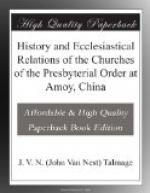Presbyterial order be scriptural, all these churches
at Amoy, growing out of each other, are bound to associate
together, ecclesiastically. It is their duty
to submit to each other. They would also be bound
to submit to the Church of the same order in England
and America, and every other country throughout the
world, if it were possible and convenient. But
such relation is not convenient, or possible.
Therefore, we must choose that which is possible and
most convenient. It is possible, and it is convenient,
that they associate together. It is not possible
that they all be subject to the Church in England,
and, at the same time, to the Church in America.
It is not convenient that they all be subject to either
of these Churches. We do not think it is convenient
that one-half of them be subject to either of these
Churches. Besides the sin, or evil, of schism,
they never can be properly represented in the higher
ecclesiastical bodies of either of these Churches.
They never can have an Elder present (I speak now
of their connection with the Church in America, for
this is the subject before us). They never can
have a full representation of ministers. Only
very seldom can they have even one minister present.
He usually will only be one who is ill, and consequently
not a proper representative. The native element,
i.e., the chief element of the Church can never
be represented at all. The representation, at
the best, will only be a representation of your Missionaries,
not at all of the Chinese Church. Therefore, we
assert that such a union would not be
real,
not even
apparent, only
nominal.
In striving after it, we are pursuing a chimera, destroying
a substance for the sake of a shadow.
But it is offered as an objection to our views, that
the Presbyterian Church (O.S.) has Presbyteries and
Synods in India and China. Yes, they have three
Presbyteries and a Synod in India, and have had for
twenty years. But even yet there is not so much
of a native element in their whole Synod as there
is already in the little Church in the region of Amoy.
As an ecclesiastical body, it is not Indian
in its characteristics—it is American.
So with all their Presbyteries in Siam and China,
with the exception, perhaps, of the Presbytery at
Ningpo. They are American Presbyteries,
not native in their character.[2]
[Footnote 2: The following statistics are from
the Minutes of General Assembly, 1863.
Synod of Northern India—Was organized
in 1841. Is composed of three Presbyteries.
Now has 19 ministers (only one of these is a native
pastor); 9 churches; 246 communicants. (How many
of these are natives not reported.)
Presbytery of Canton—Has 4 ministers;
no native pastor; 1 church; 12 communicants. (How
many of these are natives not reported.) Presbytery
of Ningpo—Has 8 ministers; no native
pastor; 2 churches; 111 native members.




